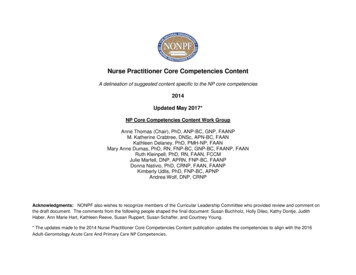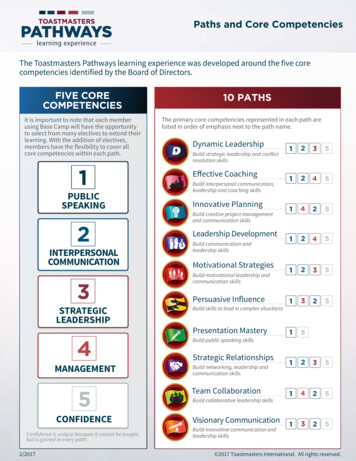
Transcription
CalMHSA’s2022 Landscape AnalysisSupervisors’ FundamentalCore Competencies forSupervision of the Peer WorkerIntroductionWhen entering the Certified Peer Specialist job industry, it quickly becomes apparent thatsupervisor standards and core competencies are crucial for a well-functioning peercertification program. In fact the National Association of State Mental Health ProgramDirectors (NASMHPD) talk about this in their “Enhancing the Peer Provider Workforce:Recruitment, Supervision and Retention” document. This document states that, “The
relationship of the worker and supervisor is one reason why peers stay or leave; they arenot leaving the job in many cases, they are leaving the supervisor.”1 That information isimportant to keep in mind while developing California’s supervisor standards.The Substance Abuse and Mental Health Services Administration (SAMHSA) noticed this in2017 when they, “. became aware of growing member concerns about supervisioncontradicting or conflicting with core peer support values.”2 To address this issue, bothSAMHSA and the National Association of Peer Supporters (N.A.P.S.) outline their own list offundamental core competencies that supervisors should possess.Currently there are some states that use SAMHSA’s supervisor fundamental corecompetencies for their supervision standards. The states that do not use SAMHSA’s corecompetencies have a created list of their own standards that follow similar themes.For the purposes of this report, a list of the SAMHSA core fundamentals and N.A.P.S.’s 12core values will be used to do a landscape analysis on how all the different states aresetting up their supervision standards currently.Research Methods of Core Competencies for SupervisorsSAMHSASAMHSA uses a list of core competencies (called fundamentals) along with the BringingRecovery Supports to Scale: Technical Assistance Center Strategy’s (BRSS TACS) resourcesfor supervision standards. These two sources were referred to when analyzing each state’sstandards of supervision. Public information on each state was pulled from the webpertaining to their training and supervision policies and standards.1*Assessment 1 - Enhancing the Peer Provider Workforce 9-15-14.pdf (nasmhpd.org)National Practice Guidelines for Peer Support Specialists and Supervisors Psychiatric Services(psychiatryonline.org)2
To understand the core definition of supervision, we can look to SAMHSA who definessupervision as,“. a professional and collaborative activity between a supervisor and a worker in which thesupervisor provides guidance and support to the worker to promote competent and ethicaldelivery of services and supports through the continuing development of the worker'sapplication of accepted professional peer work knowledge, skills, and values.”SAMHSA’s Core Fundamentals (Competencies) for Supervisors1. Understands Peer Roles and Practices2. Have Recovery-Orientation and Model Recovery-Oriented Practices3. Development of the Unique Knowledge and Skills Needed for Peer Support Practice4. Recognize the Connections between Behavioral Health Conditions and Trauma,Health Disparities, and Social Inequity5. Use Strengths-based Supervision6. Provide a Space to Address Ethical and Boundary Issues7. Advocate for the Integration of Peer Workers in the Work PlaceAcross the country, a majority of the states do not specifically mention SAMHSA’s corefundamentals for supervisors. However those same states list standards for supervisorsthat are similar to SAMHSA’s.N.A.P.S.N.A.P.S. looks at 12 core values that they developed from peer surveys and focus groups,peer leaders at SAMHSA, information collected from a National Supervision workgroup,and peer specialists and supervisors.These 12 core values are:1. Peer support is voluntary2. Peer supporters are hopeful
3. Peer supporters are open minded4. Peer supporters are empathetic5. Peer supporters are respectful6. Peer supporters facilitate change7. Peer supporters are honest and direct8. Peer support is mutual and reciprocal9. Peer support is equally shared power10. Peer support is strengths-focused11. Peer support is transparent12. Peer support is person-drivenAfter analyzing how the states’ standards follow similar themes with SAMHSA, this reportwill analyze if and how these core values are integrated in the current standards.Comparative Analysis of SAMHSA Supervision StandardsThe following states use SAMHSA’s core fundamentals for supervisors:Alaska, Idaho, Louisiana, Missouri, New Mexico, New York, PennsylvaniaThe following states do not use SAMHSA, but have standards very similar to theirs:Arkansas, Arizona, Colorado, Connecticut, Delaware, Hawaii, Illinois, Kentucy, Maine,Minnesota, Mississippi, Montana, North Carolina, North Dakota, Ohio, Oklahoma, Oregon,Rhode Island, South Carolina, Tennessee, TexasThe following states use SAMHSA core fundamentals for their peer workers, but notspecifically for supervisors:Florida, Georgia, Indiana, Iowa, Maryland, Massachusetts, Nebraska, New Hampshire, Utah,Washington, Wisconsin,
All states, however, seem to agree upon the three areas of supervision. These areas are:Administrative, Educational, and Supportive.Below is a comparative list of core themes that both SAMHSA and other states have electedto use for their supervisor standards.SAMHSA Supervisor Fundamentals3Summary of Themes Across OtherState StandardsUnderstands Peer Roles and Practices: Supervisors understand the variety of peerroles Supervisors have a deep understanding ofthe core competencies of peer workersunderstanding of peer specialist role, and Supervisors understand the specific peerbe able to identify specific duties theysupport job of the person they supervisemust carry out. Supervisors can learn more about thefundamentals of peer support and peerroles by: Participating in trainings designed forpeer support workers Reading articles about peer delivered recovery support services Learning the core competencies ofpeer workers3Have a clear and comprehensiveSupervision of Peer Workers (samhsa.gov)
Have Recovery-Orientation and ModelRecovery-Oriented Practices: Supervisors endorse and enact recovery oriented practices and values Supervisors believe in the capacity of peerworkers to grow and develop professionally Supervisors frame difficulties as learningUnderstand what the philosophy ofrecovery means, and what that entails foreach peer.Encourage maintained recovery amongtheir peers.opportunities and structure learningopportunities to help the worker grow Supervisors support the development ofindividualized professional goals Supervisors support the integration ofpeer workers and recovery valuesDevelopment of the Unique Knowledgeand Skill Needed for Peer SupportPractice: Supervisors teach workers the knowledgeand skills they need to perform work tasks Supervisors evaluate work performancethrough direct observation, co-working,assessments, and reflection, all incollaboration with the peer workerBuild peer’s skills in the peer specialistcore competencies.Reinforce peer specialist skills andencourage growth through strengthbased teaching.
Supervisors structure learningopportunities to help workers grow Supervisors advocate for worker’sparticipation in ongoing training4. Recognize the Connections betweenBehavioral Health Conditions andTrauma, Health Disparities, and SocialInequity: Supervisors take a holistic view of aLearn about peers and the diverseperson, that they are more than theirbackgrounds they come from.diagnosis or addiction Supervisors recognize that recoveryinvolves more than symptom reduction orabstinence Supervisors recognize the interconnectednature of social categorizations such asrace, class, and gender as they apply to agiven individual or group, regarded ascreating overlapping and interdependentsystems of discrimination or disadvantage Supervisors support workers to addressissues of poverty, trauma and discriminationContinue to build upon their knowledge ofrecovery in these new perspectives.
Use Strength-based Supervision:Strengths - based supervision is acollaborative process between the workerand supervisor enabling them to deliverquality services and supports that draws onthe person’s strengths and assetsRecognize the strengths of individual peer Seek to discover and amplify the workers’specialists and support goals that build onstrengths and competenciesthese strengths. Intentionally identify and amplify theworkers’ success Encourage learning and shareresponsibility for setting learning goals Focusing on strengths does not meanignoring problems, but rather means thatthe supervision frames problems aslearning opportunities Feedback and self-assessment are tools instrengths - based supervisionProvide a Space to Address Ethical andBoundary Issues: Most peer workers have been trainedabout ethics and follow a Code of Ethics that
has been adopted by the state in which theyIdentify the code of ethics for peerworkspecialists and emphasize these in theenvironment. Supervisors review agency code of conductwith the people they supervise Peer workers are expected to follow boththeir Code of Ethics and the agency’s codeof conduct The nature of peer support means thatboundary issues can be very nuanced andmay require opportunities to reflect with amore experienced colleagueAdvocate for the Integration of PeerWorkers in the Work Place: Supervisors educate others in the workAdvocate for peers in the organizationforce about the peer support roles andand to human resources.practices [how it complements otherservices in the system. How does our job fitIn addition to this, advocate for moreinto the whole system. How the peerprinciples of recovery and peer support inenhances the quality of care.]the organization. Supervisors create opportunities for peersupport workers to interact with other teammembers [interact and partner with]
Supervisors work with leadership to createmore optimal working conditions for peerworkersSummary of Comparative Analysis of SAMHSA Supervisor Core FundamentalsThere is a clear consensus between all states that most of SAMHSA’s core competencies forsupervisors are important standards to uphold. However the standard to recognizebehavioral health conditions and trauma, health disparities and social inequity, is one thatis not specifically spelled out in many of the states’ lists. That being said, those statesrecognize the importance of understanding peer’s trauma, social inequity, behavioralhealth conditions and health disparities, by understanding and individualizing theirsupervision to each peer.Comparative Analysis of N.A.P.S. 12 Core ValuesBelow is a comparative list of N.A.P.S. core values and the corresponding SAMHSA corefundamentals that fall in a similar vein with N.A.P.S.’s core values.N.A.P.S.4 Core Values“The Supervisor Role Is To: sts-and-Supervisors-1.pdf(Review)- Adobe Document Cloud
SAMHSA SupervisorFundamentals51. Peer Support is Voluntary Encourage peer support specialists inpromoting individuals’ choices includingbecoming more knowledgeable about traumainformed approaches that reduce or eliminateDevelopment of the Uniqueforce and coercion to create a saferKnowledge and Skill Needed forenvironment for all.Peer Support Practice: Explore peer support specialists’ choicesabout how they might or might not choose towork with certain individuals, especially ifthere are issues related to dual relationshipsor trauma. Provide guidance to peer support specialistswhen they are advocating for choice orspeaking up when coercion occurs, especiallywhen it is subtle or systemic.5Supervision of Peer Workers (samhsa.gov)Provide a Space to Address Ethicaland Boundary Issues
2. Peer Supporters are Hopeful Demonstrate confidence in peer specialists’ability to share a hopeful message. Provide a way to further develop skills fordisclosing personal experience with the goalsof inspiring hope, developing trust andrapport, and fostering strengths.Development of the UniqueKnowledge and Skill Needed forPeer Support Practice: Model self-care, appropriate boundaries,and an authentic belief in recovery throughlanguage, attitude, and actions.3. Peer Supporters are Open Minded View differences as an opportunity forlearning. Refrain from seeing differences aspathology (symptoms); consider “whathappened?” rather than “what’s wrong?” Learn with and from peer support specialistsabout different pathways to recovery andalternate perspectives about individuals. Respect peer support specialists’ individualrecovery journeys and knowledge of recoveryapproaches.Recognize the Connectionsbetween Behavioral HealthConditions and Trauma, HealthDisparities, and Social Inequity:
4. Peer Supporters are Empathetic Practice effective listening that is nonjudgmental and empathic while balancing theneed to hold peer support specialistsProvide a Space to Address Ethicalaccountable for their job duties.and Boundary Issues Provide adequate time and space, withcoaching and feedback, for peer specialiststo become proficient in this critical skill.5. Peer Supporters are Respectful See peer support as different from traditionalservice, one that does not start with theassumption that there is a problem. Instead,peer support is a way of relating to manyUnderstands Peer Roles andPracticesdifferent world views. Gain awareness of one’s own world viewincluding personal stigmas, stereotypes andbias that can interfere with the ability to treatall employees, including peer supportRecognize the Connectionsbetween Behavioral HealthConditions and Trauma, HealthDisparities, and Social Inequity:specialists, with respect and fairness. Take training themselves and supportProvide a Space to Address Ethicaloffering all agency employees, includingand Boundary Issuessupervisees, training on cultural humility,which is a process of openness and selfawareness that incorporates self- reflection
and self-critique while willingly interacting withindividuals from diverse cultures, ethnicitiesand gender orientations. Invite ongoing feedback on personal andstaff practice of cultural humility.6. Peer Supporters Facilitate Change Define and model advocacy for peer supportspecialists, including advocating fororganizational changes. Coach peer support specialists on how torespect the rights of individuals while helpingindividuals challenge and overcome injustice. Build on lived experience, model recoveryand advocate for peer support workers.Advocate for the Integration ofPeer Workers in the Work Place Assist colleagues with understanding thepeer specialist role and the perspective andexperience of peer support specialists. Identify situations in which the supervisorhas responsibility to address agency liabilityand maintain respectful communication with
peer support specialists when differences ofopinion occur. Provide time and support for peer supportspecialists to connect with and participate inthe greater peer movement and the peerworkforce profession.7. Peer Supporters are Honest and Direct Establish clear boundaries, set reasonableand mutually agreed- on expectations. Promote responsibility and accountability.Have Recovery-Orientation andModel Recovery-Oriented Practices:Provide a Space to Address Ethicaland Boundary Issues Build trust and develop the integrity of thesupervisory relationship with peer supportspecialists through honest and respectfulcommunication about strengths and areasthat need improvement.
8. Peer Support is Mutual and Reciprocal Ask peer support specialists how they bestDevelopment of the Uniquereceive feedback and direction.Knowledge and Skill Needed forPeer Support Practice: Encourage co-learning (collaborativelearning) and welcome peer supportspecialists’ input in decision-making whereverUse Strength-based Supervision:possible. Welcome feedback from peer supportProvide a Space to Address Ethicalspecialists during supervision sessions toand Boundary Issuesdevelop supervisory relationships based onmutuality.9. Peer Support is Equally Shared Power Educate peer support specialists on theconcept of power and the potential forinadvertently reinforcing power differentials inHave Recovery-Orientation andthe peer support relationship.Model Recovery-Oriented Practices Reinforce the non-clinical nature of the peerDevelopment of the Uniquesupport role with peer support specialists andKnowledge and Skill Needed forother organizational colleagues to avoid ‘peerPeer Support Practice:drift’ or co-optation, and role ambiguity.
Recognize the Connections Consider how power in relationships,between Behavioral Healthincluding the relationship between theConditions and Trauma, Healthsupervisor and peer support specialist, affectsDisparities, and Social Inequity:those with histories of trauma, to create a safework environment. Support peer support specialist values andscope of non-clinical practice, especially insituations in which the peer support specialistis called upon to endorse or enforce a form oftreatment or clinical practice.10. Peer Support Strength-Focused Model a focus on strengths rather thandeficits with all employees. Encourage peer support specialists todevelop meaningful personal, career, andleadership development goals and suggestthey use a similar process with those theysupport. Encourage peer support specialists to use astrength-based approach to evaluate theirown progress and performance; invite them toHave Recovery-Orientation andModel Recovery-Oriented Practices:Use Strength-based SupervisionAdvocate for the Integration ofPeer Workers in the Work Place
provide a similar strength-based approachwhen working with others.11. Peer Support is Transparent Use the job description to orient peersupport specialists to job duties andrequirements, including the type ofdocumentation a peer support specialist isexpected to keep, and to guide understandingof the performance review process. Explain the supervisor’s role, includingconnecting peer support specialists to othercolleagues with additional expertise, asneeded. Describe the benefits and expectations of thesupervisory relationship, including frequencyand duration of supervision meetings. Use plain, person-first language in allinteractions with peer support specialists.Understands Peer Roles andPractices
Reinforce the non-clinical nature of the peersupport role with peer support specialists andcolleagues, including documentation which isconsistent with the peer support role.12. Peer Support is Person-Driven Provide an environment where peer supportspecialists are empowered to move beyondcomfort zones and learn from their mistakes. Reframe unexpected outcomes asHave Recovery-Orientation andModel Recovery-Oriented Practices:opportunities for personal growth, recovery,and resilience. Assist peer support specialists in identifyingareas for personal growth and creatingprofessional development plans. Recognize when the issues a peer supportspecialist brings up in supervision are beyondthe supervisor’s role; and suggest constructiveways to obtain help for these issues.Use Strength-based Supervision:
Summary of Comparative Analysis of N.A.P.S. Core Values and SAMHSA’sFundamentalsWhile SAMHSA’s core fundamentals are already pretty thorough, N.A.P.S.’s 12 core valuestake it one step further. The 12 core values emphasize the type of mindset a supervisorshould possess. They describe a work environment that empowers the peer specialist andkeeps the supervisor constantly in a space of learning and adapting to best support theirpeer workers.Current Qualifications for Supervisors: Landscape AnalysisRequirements for supervisors varied state by state. However, a large number of statesrequire supervisors to have professional experience. Delaware, for example, states thattheir, “.certified peer staff is supervised by a licensed practitioner of the healing arts who isacting within the scope of his/her professional license and applicable state law.”6 (4.b.)States like Kentucky are more specific and require more qualifications to be a supervisor.Kentucky requires supervisors to be a professional, including but not limited to: a Physician,a Psychiatrist, an Advanced practice registered nurse, a Physician assistant, a Licensedpsychologist and more.7 (Section 6)Other states give trainings for peers to be supervisors. This is typically after the individualhas been a peer themselves for a selected amount of time.67DEPARTMENT OF HEALTH AND SOCIAL SERVICES (delaware.gov)908 CABINET FOR HEALTH AND FAMILY SERVICES - DEPARTME Chapter: \908\002.220 (ky.gov)
CalMHSA Peer Support Specialist Stakeholder AdvisoryCouncil FeedbackOur stakeholder advisory council subcommittee analyzed this landscape report and gavetheir feedback on supervisory fundamentals they wanted to emphasize for theimplementation of the Medi-Cal Peer Certification Program.In addition to the skills listed below, supervisors should be well trained in the skill set ofsupervision.Supervisors should provide regular supervision, both individually and as a team, doneideally on a weekly basis. These supervisor meetings are a coaching opportunity that canhelp address problems and create a learning environment for the team.A common theme amongst the advisory council was the desire for supervisors to gothrough the peer specialist training in addition to their supervisor training, so thatsupervisors are clear on the expectations of peer specialists.The council believed that supervisors should value the peer support role among otherroles. In fact, the advisory council recommended that as much as possible, supervisorshave lived experience, following the BHIN.The advisory subcommittee recommended trauma-informed training for supervisors forthe relationship between the supervisor and peer specialist. In addition to this, theyrecommended developing an environment of mutual learning, especially for circumstanceswhen the supervisor is not a peer.The advisory subcommittee really appreciated the SAMHSA and N.A.P.S. mentions ofsupervisors encouraging and advocating for peer’s career development and increasedleadership. They recommended building a career ladder for peer support. But in saying so,they also mentioned that peer specialists should not be required or expected to move upthe career ladder if they do not wish to do so.
A few concerns from the advisory council included questions of how to measure when asupervisor has met the SAMHSA core competencies, N.A.P.S core values and thesubcommittee suggested criterion.The advisory subcommittee was split in whether to completely adopt the N.A.P.S. corevalues and SAMHSA core competencies, or to adopt both these standards but makeadjustments to fit the feedback from the advisory council.In ConclusionAlthough there are many differences between states in standards of a supervisor, the mainpillars of administration, education and support are seen consistently throughout theirsupervisor trainings. To get a more thorough look at the states’ peer supervisor standardsand core competencies, a formal outreach to all the states’ peer programs and leaderswould be necessary.That being said, the SAMHSA’s supervisor core competencies and the N.A.P.S. 12 corevalues are together a great foundation for creating supervisor standards for California’speer certification program. Lastly, stakeholders and subject matter experts will beimperative to finalizing the most effective supervisor standards possible for California.Index of Resources“Supervision of Peer Workers” by the Substance Abuse and Mental Health ServicesAdministration (SAMHSA); Supervision of Peer Workers (samhsa.gov)“National Practice Guidelines for Peer Specialists and Supervisors” by the NationalAssociation of Peer Supporters (N.A.P.S.); nd-Supervisors-1.pdf(Review)- Adobe Document Cloud ; National Practice Guidelines forPeer Support Specialists and Supervisors Psychiatric Services (psychiatryonline.org)
“The Peer Provider Workforce: Recruitment, Supervision and Retention” by the NationalAssociation of State Mental Health Program Directors (NASMHPD); *Assessment 1 Enhancing the Peer Provider Workforce 9-15-14.pdf (nasmhpd.org)“Supervision of Peer Workers” by Bringing Recovery Supports to Scale (BRSS TACS);Supervision of Peer Workers Toolkit (peersupportworks.org)“Supervision Resources” by N.A.P.S.; Supervision Resources - National Association of PeerSupporters (peersupportworks.org)“Integrated Care In Action Podcast: Strategies For Effective Peer Supervision” by BeverlyHaberle ( Executive Director, The Council of Southeast Pennsylvania, Inc.); Lena Marder(Clinical Supervisor for Peer Specialists, The Council of Southeast Pennsylvania, Inc.); andFred Shue (Certified Recovery Specialist, The Council of Southeast Pennsylvania, Inc.) ;Integrated Care in Action Podcast: Strategies for Effective Peer Supervision Resources forIntegrated Care“Hiring and Supervising Peer Providers to Support Integrated Care” by Larry Fricks SAMHSAHRSA Center for Integrated Mental Health Solutions; Hiring and Supervising Peer Providersto Support Integrated Care (thenationalcouncil.org)“Mastering Supervision Moving From Effective to Excellent” by: Jeanne Supin MA, JakeBowling MSW, Nick Szubiak MSW LCSW ; National Council for Behavioral Health;PowerPoint Presentation (thenationalcouncil.org)“Peer Supervision Trainings” by The CAFE TA Center; Peer Supervision – Cafe TA Center“Oh No! We’ve Hired Consumers!!! Personnel Policies & Practices for People in Recovery(and Everyone Else)” by Joshua Koerner, B.A. – Executive Director, CHOICE Co-President,NYAPRS Deborah Max – Deputy Director, CHOICE; Microsoft PowerPoint - ppt. Oh No WeveHired Consumers v2 (illinoismentalhealthcollaborative.com)
“PEER SUPERVISION: WHAT’S WORKING, HOW AND WHY?” by Jessica Wolf, PH.D., DecisionSolutions; Peer-Supervision-Wolf.pdf (peersupportworks.org)“Peer Support Toolkit” by Department for Behavioral Health and Intellectual disAbilityServices; Peer Support Toolkit - DBHIDS“Strategies for Supervising Peer Support Workers (April 2017)” by SAMHSA; Strategies forSupervising Peer Support Workers (April 2017) - YouTube“Substance Use Disorder Peer Supervision Competencies” by Eric Martin, MAC, CADC III,PRC, CPS & Anthony Jordan, MPA, CADC II, CRM; The Regional Facilitation Center; PeerSupervision-Competencies-2017.pdf (williamwhitepapers.com)“Supervising Peer Support Staff: What does it take?” by SAMHSA; FOUNDATIONS OF(peersupportworks.org)“Supervision and Peers: Opportunity for Paradigm Shift” by Gita Enders, MA, CPRP,Jonathan P. Edwards, LCSW, ACSW, M.Phil.; SUPERVISION AND PEERS(peersupportworks.org)“Supervisor Guide: Peer Support Whole Health and Wellness” by National Association ofState Mental Health Program Directors (NASMHPD), Georgia Department of BehavioralHealth and Developmental Disabilities (DBHDD), Georgia Mental Health ConsumerNetwork; Microsoft Word - TTI PSWHWC Supervisor Manual 0613 3(peersupportworks.org)“Peer Supervision: Training and Credentialing Peer Supervisors” by Florence Alberque, HollyDixon, iNAPS 2016; 2016.pdf(peersupportworks.org)“Trauma-Informed Peer Supervisory Practice” by Inspired Vision LLC; Trauma-InformedSupervision-Cave Johnsan.pdf (peersupportworks.org)
“Supervisory Repository” by iNAPS; Microsoft Word - Annotated Bibliography for iNAPSSuper Repository.docx (peersupportworks.org)“A Guide to Supervising and Developing Young Adult Peer Mentors” by Vanessa V. Klodnick,a Senior Researcher at Thresholds, Massachusetts Department of Mental Health, Universityof Massachusetts Transitions Research & Training Center;Supervision Guide for YA Peers v7 with PP icons pdf.pdf (squarespace.com)
recognize the importance of understanding peer's trauma, social inequity, behavioral health conditions and health disparities, by understanding and individualizing their supervision to each peer. Comparative Analysis of N.A.P.S. 12 Core Values Below is a comparative list of N.A.P.S. core values and the corresponding SAMHSA core











